If you’ve read SaaStr or have been around for the last decade, you might be familiar with some of the repeated GTM mistakes founders tend to make, but the world of hiring, people, scaling, and workplace expectations are significantly different today than they were before March 2020.
SaaStr Founder and CEO, Jason Lemkin, shares the top GTM mistakes founders make today and some cheat codes to avoid them. Some are mistakes we make again and again, and others are newer territory as we evolve.
Mistake #1: A VP of Sales that Can’t Sell or Demo the Product
“Whatever you do, do not hire a Head of Sales who can’t demo the product before day one,” Jason says. The same is true for your first 5-10 reps. If they can’t demo the product before they sign the offer letter, don’t make the hire. If the VP of Sales needs someone to do the demo for them, or they won’t carry a bag… you guessed it. Don’t make the hire.
A huge mistake founders make is hiring someone who hasn’t sold in your space before. Maybe you’re doing vertical SaaS, selling to governments, or it’s a more complicated product than they’ve sold before.
You don’t want someone who talks only about processes, people, hiring philosophies, quota, and their views on revenue attainment because they’ll never learn the product. If they don’t learn the product before they start, they never will in most cases.
Likely, 80-90% of founders never force the VP of Sales to demo the product before starting the job, and that’s a mistake. You don’t have the resources or the brand to carry you, so your VP of Sales needs to know the product and how to sell it.
Mistake #2: A VP of Marketing that Can’t Do Demand Generation
Don’t hire a product marketer, a corporate marketer, or a strategist. Find out if your potential hire held a commit at their last role. Jason was talking to a founder at $14M-$15M, and they weren’t sure if their Head of Marketing was working out. They weren’t getting any leads.
What was this Head of Marketing’s previous role? A junior product marketer at Gitlab. Do you know what product marketers do at big tech companies? They don’t get you leads. They likely don’t even know who is on the sales team.
What this hire was doing was building out different landing pages. Should you fire someone like that if they’re smart and doing a good job at something they weren’t hired for? Not necessarily.
Jason suggested leveraging this person’s talents and having them build landing pages and host a weekly webinar explaining the product. It won’t be demand gen, so finding someone who can generate leads is important.
If you’re looking for someone good at demand gen, don’t hire someone on LinkedIn whose first line is labeled “strategist,” “corporate marketer,” or communications anything. Those people, especially strategists, won’t execute on anything or aren’t needed until your company is more mature. To find someone who knows their stuff, ask them what their commit was at their last role.
A real growth marketer will say $5M in pipeline per quarter or 300 MQLs or 2,000 signups. More from Jason about hiring the wrong type of VP of Marketing here.
Mistake #3: Stepping Out of Sales
The number three mistake Jason sees founders make is exiting sales as things start to take off. It’s truer today because even though fundraising is harder, folks raise bigger rounds. They’ll raise $10M or $20M and say, “Thank god, I don’t have to do sales or Zoom calls anymore. I have to get back to product.”
There’s a lot of truth in that, which is why you should hire a great VP of Product far earlier than most founders are, but stepping away from sales isn’t how things work.
You have to do more in product and do the same amount of time in sales. When you hire a great sales leader, your job will be different. Instead of opening and closing every conversation, you’ll get pulled into the middle more often.
But never step out of sales. No one will ever know as much about your product’s nuances or whys, so you have to support sales that way.
Mistake #4: Cutting Marketing Too Deeply
If growth is down and cash is tight, you have to do something. But cutting marketing to zero isn’t the answer. You’ll be cutting your future potential. This one is new and didn’t happen in ‘08 or ‘09. Even then, marketing wasn’t cut to zero.
All struggling startups today are cutting marketing to zero, and it’s your job as founders and executives to find the balance here. If cash is tight, the first thing you look at are variable costs and the bottom 10%. Layoffs are tough, but everyone does better the next day when you cut the bottom 5-10% because they no longer consume time, energy, and resources.
Then, you look at variable costs, and you cut marketing. So many founders have seen slow growth, and when asked how pipeline is, they say it’s really slow, too. “How much are you spending on marketing?” Jason asks. What do you think they say? Zero. They’re spending nothing on marketing.
Instead, they say they’re doing all the free stuff, like spending three months starting a podcast. That’s “free,” but what about all the soft costs and time? Some go for content marketing because it’s cheaper, but is the content amazing? No, it’s terrible. You have to do the free stuff. It always works. But it almost never works unless you have an inherently viral app and word of mouth.
What’s actionable here? Rather than cutting to zero, unless you’re running out of time and runway, find a Head of Marketing that you trust to spend a set amount of budget as effectively as they can. And don’t expect it to convert tomorrow.
Marketing doesn’t convert overnight. But if you cut it, you might help in the short term at the sacrifice of your future.
Mistake #5: Not Properly Jumping on the AI Bandwagon
AI hasn’t changed every B2B and SaaS space in 60 seconds. The fact that two phones can talk to each other doesn’t mean your payroll app is magically better. Just because you can type some text and get a cartoon doesn’t mean you’re making your customers happier.
But you can’t hide from it, and too many founders are. Yes, hiring engineers is expensive, and maybe it’s not revolutionizing your space yet. But you will lose the deal if you’re not at feature parity in AI with your competition. You have no choice.
Many startup founders argue against this tsunami coming in, saying it doesn’t work, but you can’t fight this trend and the billions being deployed every week. This is where budget is.
Mistake #6: Putting Profitability Above Growth
People are getting this wrong on LinkedIn and social media. We’re in a new era of efficiency, with the average public SaaS company doing almost $400k in revenue per employee. So, they’re over twice as efficient as in 2021, where it was $100k per employee.
Efficiency matters, but profitability doesn’t on its own. Folks who aren’t growing but are profitable aren’t the folks you want to be. No one says, “Hooray, we’re profitable even though we aren’t growing.”
There is some truth that you still want to grow at outlier rates as you pass $10M or $20M in revenue-triple, triple, double, double. The best startups go from $1M-$3M, $3M-$9M, $9M-$18M, and $18M-$36M. It sounds like a lot, but if you want to get to $200M in revenue in less than ten years, it takes that amount of compounding.
The reality is, if you’re efficient at $10M to $20M, which is 30% or more growth and break even, you can get great PE exits and an offer for $200-$300M to buy your company. But growth has to be north of 30. There is no world where profitability is above growth.
Mistake #7: Hiring the Broken, the Bitter, the Fractional
The world has really changed since March 2020. For some folks today, it’s the hardest it’s ever been. Some SaaS leaders with hundreds of millions of revenue are growing at 0%. Others are more similar to 2018 when budgets had to be earned.
This has led to a lot of folks who are broken, bitter, and fractional. Folks who don’t want to do it anymore. You can’t hire anyone that won’t play the entire game. It’s too hard today.
They can’t be too angry at their last boss, think the system is loaded against them, believe that VCs are destroying people with their liquidation preferences, or think that the CEO is a terrible human being.
There is likely some truth in those things, but you can’t hire those people. A little chip on your shoulder is probably necessary for success in founders and VPs. A great background for your first VP is someone who says, “I was Director or Head of Sales and got the company to $20M. Then they topped me with a CRO from a big company, and I’m pissed.” That’s great.
You can’t hire that person when the chip is so heavy that it’s a rock weighing you down. They can’t recover.
Mistake #8: Hiring for the Logo
We all keep making this mistake of hiring someone because they worked for [insert Big Fancy Company]. This is an evergreen error and is even more prevalent now because so many folks are coming out of Datadog, Notion, Cloudflare, Zoominfo, Zoom, and other iconic companies.
Most don’t want to hire from a direct competitor because you’ll overlook the downsides, but an early guy from Datadog might be a good solution. Or it might not. When hiring someone, sit down with your team, cover up the logos of their previous work history, and ask everyone if they would hire this person if they had never worked for that company.
Most of the time, people say no. Once in a while, hiring that early person with the right-sized chip on their shoulder is okay, but if you’re just hiring for the logo, you might want to reconsider.
Mistake #9: Looking for Instant ROI
Yes, this is harder in tougher times, but pipeline takes time. This is tied to marketing; you’re cutting off your nose if you’re doing this. Everyone is looking for instant ROI. An extreme example is right here at SaaStr. We have 200 sponsors that we use as a lab.
Last year, things switched. Instead of measuring on pipeline, opportunity, awareness, influence, or brand, they wanted scans. People come to events and get a scan. It’s the very top of a pipeline, but most marketing in normal times view it with skepticism.
Having an SDR wave a scanner in your face before you can take home rubber ducky swag may not be the best KPI. If you’re looking for instant ROI in field marketing, you might have unreasonable expectations.
Events usually take at least six months to convert, and the reality is those people are already shopping. Building raw new events is somewhere between a high-intent Google search and randomly discovering someone on a piece of content. Instant ROI is not there in the middle of an event.
On a related note, instant ROI destroys customer success and relationships with customers.
Mistake #10: Elimination of True Customer Success
The bigger companies have pushed through multiple price increases in the last few years without commensurate value. A SaaStr vendor with a new CRO said they were doubling prices and to take it or leave it. It burned the relationship forever, and you don’t want to burn your base.
It might help you make this quarter, but will those people refer customers to you? At the end of the day, all software is powered by word of mouth. That is everyone’s number one source of new customers. As founders, ask yourself if your actions in the last 18 months have damaged word of mouth.
Another problem in the world of customer success is having CS report to sales. If that’s the case, whose job is it 100%, 40+ hours a week, to make at least your top customers happy? Someone charged with upselling can’t be that.
We just put up a G2 poll across customers and found that a majority of CS teams not only report to sales now but have a sales quota. Folks did this when needing to monetize sales more, and their job has become about protecting NRR.
It has become weaponized, and we might not be able to return to customer happiness as their number one job. As a founder, figure out who your top 20% or 50 customers are, hire a team that does nothing but make those top accounts happy, and prevent future and inevitable churn.
The Top 10 Don’ts When it Comes to GTM
Don’t hire a VP of Sales that can’t sell or demo the product
Don’t hire a VP of Marketing that can’t do demand generation
As a founder, don’t step out of sales too early
Don’t cut marketing too much, or too early
Don’t ignore the adoption of AI into your business
Don’t putting profitability above growth
Don’t hire the broken, the bitter, the fractional if they’re not willing to play the game
Don’t hire for the logo if their resume can’t back it up
Don’t look for Instant ROI
Don’t eliminate true customer success



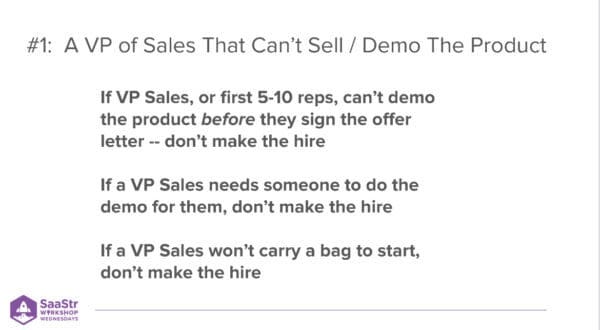
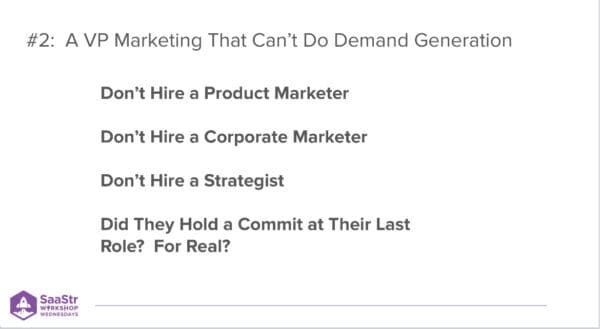
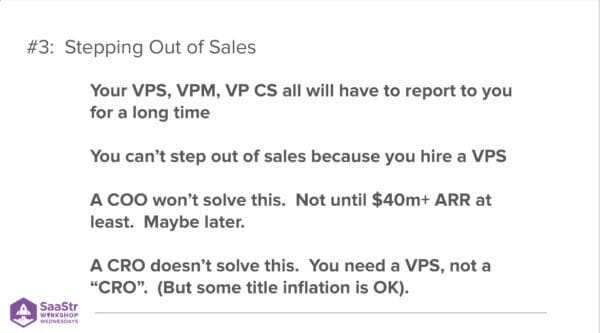
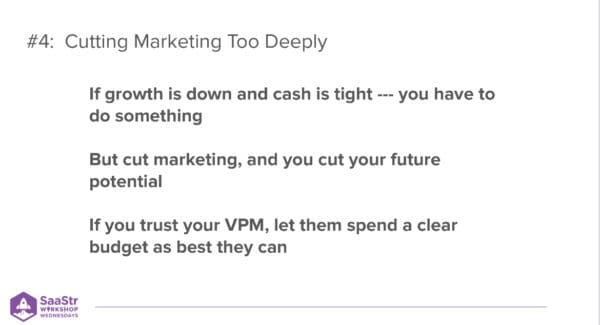
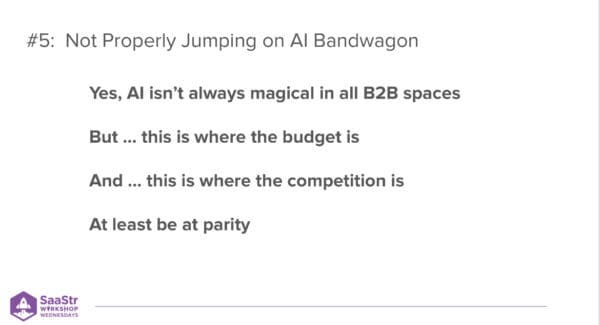
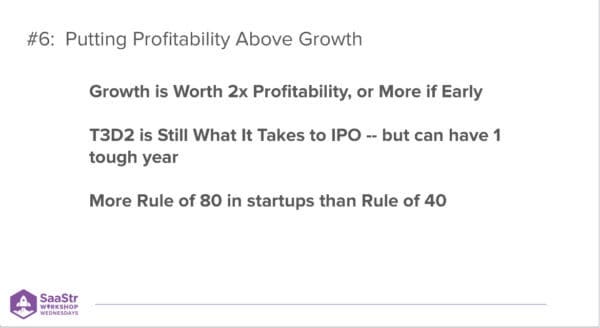
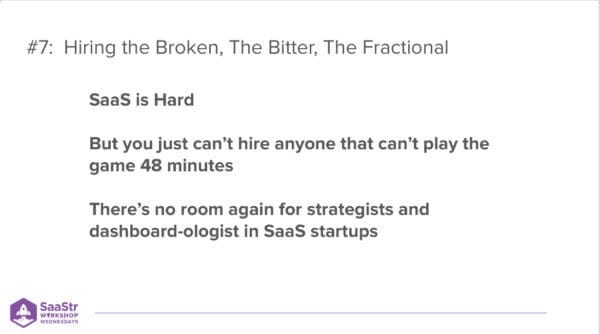
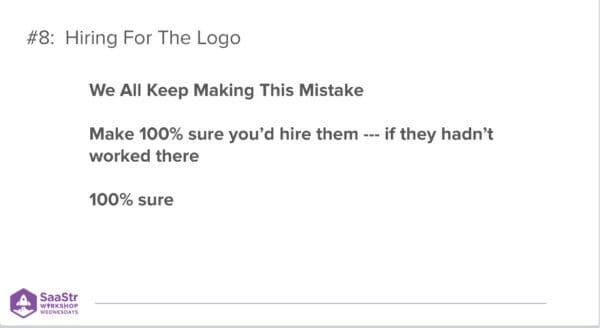
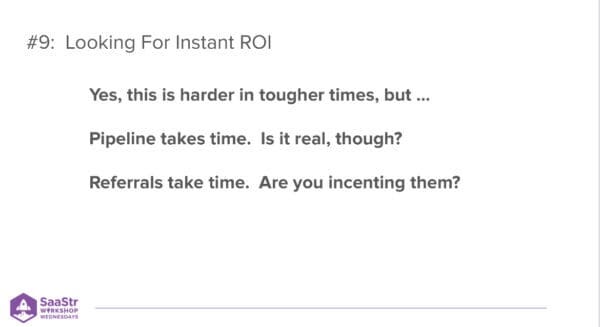
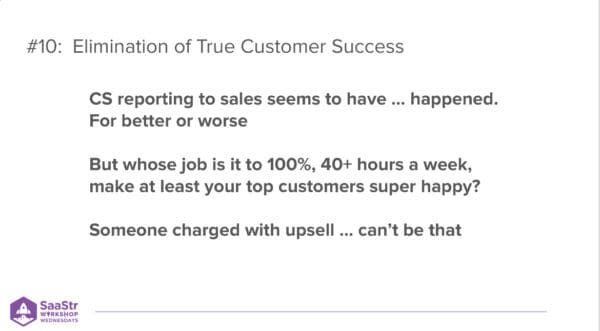





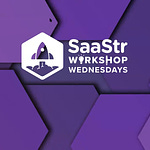





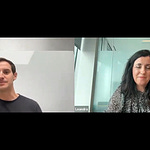



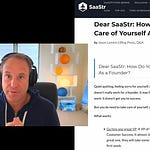
Top 10 Go-To-Market Mistakes Founders Make Today with SaaStr CEO Jason Lemkin